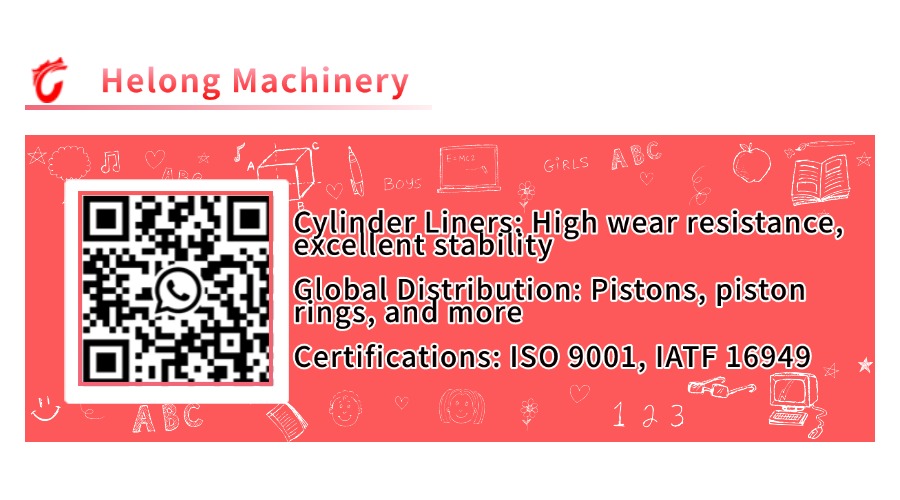工程机械发动机配件名称介绍
AddTime:2025-02-17 13:30:17 Views:
工程机械发动机配件名称介绍

1. 曲柄连杆机构配件
活塞:在气缸内做往复直线运动,通过连杆将动力传递给曲轴,需具备高强度、耐磨及良好导热性能。
活塞环:安装在活塞环槽内,起密封、导热和控油作用,防止燃气泄漏,传递热量并控制机油消耗。
活塞销:连接活塞与连杆小头,使活塞的往复运动顺畅传递给连杆。
连杆:将活塞的往复运动转化为曲轴的旋转运动,承受较大的拉伸、压缩和弯曲应力。
连杆螺栓:用于连接连杆大头和小头,需具备高强度和良好的抗疲劳性能。
曲轴:将活塞的往复运动转化为旋转运动,为工程机械提供动力输出。
曲轴轴承:支撑曲轴,减少摩擦和磨损,保证曲轴的平稳运转。
飞轮:安装在曲轴后端,储存和释放能量,使发动机运转更加平稳。
2. 配气机构配件
进气门:控制发动机进气过程,使新鲜空气或混合气顺利进入燃烧室。
排气门:负责排出燃烧后的废气,保证燃烧室内气体及时更新。
气门座圈:安装在气缸盖上,与气门配合形成密封,保证气门的密封性。
气门导管:引导气门做往复直线运动,保证气门与气门座圈的正确配合。
气门弹簧:使气门关闭并保持密封,防止气门在工作时跳动。
凸轮轴:通过凸轮的轮廓控制气门的开启和关闭时间及升程。
挺柱:将凸轮轴的运动传递给气门推杆或直接推动气门。
推杆:在配气机构中传递动力,连接挺柱和摇臂。
摇臂:改变力的方向,将推杆的推力转化为气门的开启力。
3. 燃油供给系统配件
喷油嘴:将燃油精准喷射到燃烧室内,保证燃油充分燃烧。
喷油泵:提高燃油压力,并根据发动机工况将适量燃油输送到喷油嘴。
输油泵:将燃油从油箱输送到喷油泵,保证燃油供给的连续性。
燃油滤清器:过滤燃油中的杂质和水分,保护燃油系统部件。
高压油管:连接喷油泵和喷油嘴,承受高压燃油的输送。
低压油管:用于输送低压燃油,如从油箱到输油泵的管路。
调速器:根据发动机负荷变化,自动调节喷油泵的供油量,保持发动机转速稳定。
油门踏板:驾驶员控制发动机供油量的装置,通过拉线或电子信号连接到调速器。
4. 润滑系统配件
机油泵:将机油从油底壳抽出,加压后输送到发动机各润滑部位。
机油滤清器:过滤机油中的杂质,保证机油清洁,延长发动机使用寿命。
机油散热器:降低机油温度,防止机油因高温而变质,影响润滑效果。
机油压力传感器:监测机油压力,将压力信号传递给仪表盘或发动机控制系统。
机油标尺:用于检查发动机油底壳内机油的液位。
油底壳:储存机油,并为润滑系统提供必要的机油容量。
5. 冷却系统配件
散热器:通过空气散热,将冷却液中的热量散发到大气中,降低冷却液温度。
冷却风扇:加速空气流动,提高散热器的散热效率。
水泵:使冷却液在发动机冷却系统中循环流动,保证冷却液的正常散热。
节温器:根据冷却液温度自动调节冷却液的循环路径,控制发动机的工作温度。
冷却液补偿水箱:储存冷却液,补偿因温度变化而引起的冷却液体积变化。
冷却水管:连接散热器、水泵、发动机等部件,使冷却液在系统中循环。
6. 点火系统配件(针对汽油机)
火花塞:在燃烧室内产生电火花,点燃混合气,使发动机工作。
点火线圈:将低电压转换为高电压,为火花塞提供足够的点火能量。
分电器:按照发动机的点火顺序,将点火线圈产生的高压电分配到各个火花塞。
点火控制器:控制点火线圈的通断,实现对点火时刻的精确控制。
高压线:连接点火线圈和分电器,以及分电器和火花塞,传输高压电。
7. 其他配件
空气滤清器:过滤进入发动机的空气,防止灰尘等杂质进入气缸,减少发动机磨损。
进气管:引导空气或混合气进入发动机气缸。
排气管:排出燃烧后的废气,并降低排气噪声。
消声器:降低发动机排气噪声,减少对环境的影响。
气缸垫:安装在气缸盖和气缸体之间,保证气缸的密封性,防止漏气、漏水和漏油。
正时链条:连接曲轴和凸轮轴,保证两者的同步运转,确保发动机配气正时准确。
正时皮带:与正时链条作用类似,通过皮带传动实现曲轴和凸轮轴的同步。
张紧器:调节正时链条或皮带的张紧度,保证其正常工作。
发动机支架:支撑发动机,减少发动机振动对工程机械其他部件的影响。
启动机:在发动机启动时,为发动机提供初始转动动力。
发电机:由发动机带动发电,为工程机械的电气系统提供电能。
电压调节器:稳定发电机输出电压,保护电气设备。
蓄电池:储存电能,为启动机和电气系统在发动机未运转时提供电源。
水温传感器:监测冷却液温度,将温度信号传递给仪表盘或发动机控制系统。
油温传感器:检测机油温度,为发动机的运行状态监测提供数据。
转速传感器:测量发动机转速,用于发动机控制系统的各种控制策略。
爆震传感器:检测发动机是否发生爆震,以便及时调整点火提前角。
废气再循环阀(EGR 阀):将部分废气引入进气系统,降低燃烧温度,减少氮氧化物排放。
涡轮增压器:利用发动机排出的废气能量,驱动涡轮旋转,压缩进气,提高发动机的进气量和功率。
中冷器:对涡轮增压后的空气进行冷却,降低进气温度,提高进气密度,增加发动机功率。
机油冷却器:与机油散热器类似,进一步冷却机油,保证机油性能。
风扇离合器:根据发动机温度自动控制冷却风扇的转速,提高风扇的工作效率和节能。
活塞冷却喷嘴:向活塞底部喷射机油,冷却活塞,防止活塞因高温损坏。
曲轴箱通风阀(PCV 阀):控制曲轴箱内的废气排放,保持曲轴箱内压力平衡。
燃油泵继电器:控制燃油泵的工作,保证燃油泵在需要时正常运行。
启动继电器:控制启动机的电源通断,保护启动机和蓄电池。
保险丝:在电路中起过载保护作用,当电流过大时熔断,切断电路。
继电器盒:集中安装各种继电器,方便电路控制和维护。
线束:将发动机各电气部件连接起来,传输电力和信号。
油封:防止机油等液体泄漏,保证发动机各部件的正常工作环境。
O 型圈:用于密封各种接口,防止气体或液体泄漏。
衬套:安装在部件之间,起缓冲、减震和减少磨损的作用。
卡箍:固定各种管路和部件,防止松动。
螺栓:用于连接和固定发动机各部件,是发动机装配中常用的连接件。
螺母:与螺栓配合使用,紧固部件。
垫圈:增加螺栓与部件之间的接触面积,防止螺栓松动和损坏部件表面。
键:用于连接轴和轮毂等部件,传递扭矩。
销:用于定位和连接部件,保证部件之间的相对位置准确。
呼吸器:平衡发动机内部与外部的气压,防止灰尘等杂质进入。
放油螺栓:用于排放发动机油底壳内的机油。
加水口盖:密封冷却液补偿水箱的加水口,同时保持水箱内压力稳定。
加油口盖:密封发动机油底壳的加油口,防止机油泄漏和杂质进入。
真空助力器:在制动系统中,利用发动机进气歧管的真空度,辅助驾驶员踩制动踏板。
制动总泵:将驾驶员踩制动踏板的力转化为液压能,通过制动管路传递到制动分泵。
制动分泵:将液压能转化为机械能,推动制动片与制动盘或制动鼓摩擦,实现制动。
制动片:与制动盘或制动鼓摩擦,产生制动力。
制动盘:与制动片配合,实现车辆的制动功能。
制动鼓:在一些车辆中,代替制动盘与制动片配合实现制动。
制动管路:连接制动总泵和制动分泵,传递制动液压力。
制动液:在制动系统中传递压力,实现制动功能。
离合器片:在离合器中,通过与飞轮和压盘的摩擦,实现动力的传递和切断。
离合器压盘:压紧离合器片,使离合器片与飞轮之间产生摩擦力,传递动力。
离合器分离轴承:在离合器分离时,推动压盘,实现离合器的分离。
离合器踏板:驾驶员控制离合器的装置,通过机械或液压方式连接到离合器。
变速器齿轮:在变速器中,通过不同齿轮的啮合,实现不同的传动比,改变车辆的行驶速度和扭矩。
变速器轴:支撑变速器齿轮,传递动力。
同步器:使变速器换挡时齿轮能够顺利啮合,减少换挡冲击。
差速器:在车辆转弯时,使左右车轮以不同的转速旋转,保证车辆平稳行驶。
半轴:将差速器的动力传递到车轮,驱动车轮旋转。
轮毂:安装车轮的部件,与半轴连接。
轮胎:与地面接触,支撑车辆重量,传递驱动力和制动力。
转向节:连接车轮和转向系统,实现车辆的转向功能。
转向拉杆:在转向系统中,传递转向力,使车轮转向。
转向器:将驾驶员转动方向盘的力放大,转化为转向拉杆的直线运动,实现车辆转向。
方向盘:驾驶员控制车辆行驶方向的装置。
减震器:减少车辆行驶过程中的震动,提高行驶舒适性。
弹簧:在悬挂系统中,支撑车辆重量,与减震器配合工作。
悬挂臂:连接车身和车轮,传递力和力矩,保证车轮的运动轨迹。
Introduction to Construction Machinery Engine Parts Names
1. Parts of the Crankshaft Connecting Rod Mechanism
Piston: It moves in a reciprocating straight - line motion within the cylinder and transmits power to the crankshaft through the connecting rod. It needs to have high strength, wear resistance, and good thermal conductivity.
Piston Ring: Installed in the piston ring groove, it plays the roles of sealing, heat conduction, and oil control, preventing gas leakage, transferring heat, and controlling oil consumption.
Piston Pin: Connects the piston and the small end of the connecting rod, enabling the smooth transfer of the piston's reciprocating motion to the connecting rod.
Connecting Rod: Converts the reciprocating motion of the piston into the rotational motion of the crankshaft and bears large tensile, compressive, and bending stresses.
Connecting Rod Bolt: Used to connect the big end and the small end of the connecting rod, it requires high strength and good fatigue resistance.
Crankshaft: Converts the reciprocating motion of the piston into rotational motion to provide power output for construction machinery.
Crankshaft Bearing: Supports the crankshaft, reduces friction and wear, and ensures the smooth operation of the crankshaft.
Flywheel: Installed at the rear end of the crankshaft, it stores and releases energy to make the engine operation more stable.
2. Parts of the Valve Train
Intake Valve: Controls the intake process of the engine, allowing fresh air or the air - fuel mixture to smoothly enter the combustion chamber.
Exhaust Valve: Responsible for discharging the burned - out exhaust gas, ensuring the timely renewal of the gas in the combustion chamber.
Valve Seat Ring: Installed on the cylinder head, it cooperates with the valve to form a seal, ensuring the tightness of the valve.
Valve Guide: Guides the valve to move in a reciprocating straight - line motion, ensuring the correct cooperation between the valve and the valve seat ring.
Valve Spring: Closes the valve and maintains the seal, preventing the valve from bouncing during operation.
Camshaft: Controls the opening and closing time and lift of the valve through the contour of the cam.
Tappet: Transmits the movement of the camshaft to the valve push - rod or directly pushes the valve.
Push - rod: Transmits power in the valve train, connecting the tappet and the rocker arm.
Rocker Arm: Changes the direction of force, converting the thrust of the push - rod into the opening force of the valve.
3. Parts of the Fuel Supply System
Injector: Precisely injects fuel into the combustion chamber to ensure the full combustion of fuel.
Fuel Injection Pump: Increases the fuel pressure and delivers an appropriate amount of fuel to the injector according to the engine operating conditions.
Fuel Transfer Pump: Transfers fuel from the fuel tank to the fuel injection pump, ensuring the continuous supply of fuel.
Fuel Filter: Filters impurities and water in the fuel to protect the components of the fuel system.
High - Pressure Fuel Pipe: Connects the fuel injection pump and the injector, bearing the transportation of high - pressure fuel.
Low - Pressure Fuel Pipe: Used to transport low - pressure fuel, such as the pipeline from the fuel tank to the fuel transfer pump.
Governor: Automatically adjusts the fuel supply of the fuel injection pump according to the engine load change to maintain the stable engine speed.
Accelerator Pedal: A device for the driver to control the fuel supply of the engine, connected to the governor through a cable or an electronic signal.
4. Parts of the Lubrication System
Oil Pump: Draws oil from the oil pan, pressurizes it, and delivers it to various lubrication parts of the engine.
Oil Filter: Filters impurities in the oil, ensures the cleanliness of the oil, and extends the service life of the engine.
Oil Cooler: Reduces the oil temperature, prevents the oil from deteriorating due to high temperature, and affects the lubrication effect.
Oil Pressure Sensor: Monitors the oil pressure and transmits the pressure signal to the instrument panel or the engine control system.
Oil Dipstick: Used to check the oil level in the engine oil pan.
Oil Pan: Stores oil and provides the necessary oil capacity for the lubrication system.
5. Parts of the Cooling System
Radiator: Dissipates the heat in the coolant to the atmosphere through air cooling, reducing the coolant temperature.
Cooling Fan: Accelerates the air flow and improves the heat dissipation efficiency of the radiator.
Water Pump: Circulates the coolant in the engine cooling system to ensure the normal heat dissipation of the coolant.
Thermostat: Automatically adjusts the circulation path of the coolant according to the coolant temperature, controlling the working temperature of the engine.
Coolant Expansion Tank: Stores coolant and compensates for the volume change of the coolant caused by temperature changes.
Cooling Hose: Connects components such as the radiator, water pump, and engine, allowing the coolant to circulate in the system.
6. Parts of the Ignition System (for gasoline engines)
Spark Plug: Generates an electric spark in the combustion chamber to ignite the air - fuel mixture and make the engine work.
Ignition Coil: Converts low voltage into high voltage to provide sufficient ignition energy for the spark plug.
Distributor: Distributes the high - voltage electricity generated by the ignition coil to each spark plug according to the engine's ignition sequence.
Ignition Controller: Controls the on - off of the ignition coil to achieve precise control of the ignition timing.
High - Tension Cable: Connects the ignition coil and the distributor, as well as the distributor and the spark plug, to transmit high - voltage electricity.






